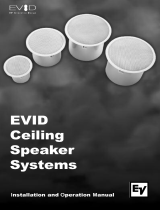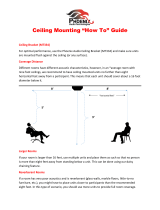
THE CEILING SPEAKER SYSTEMS – AN OVERVIEW......................................... 3
VALUE OF PREMIUM PERFORMANCE:................................................................ 3
A Unique Solution to an Age Old Problem................................................................. 3
T
HE
EVID S
OLUTION
– W
HY IS IT
D
IFFERENT
? .............................................................. 3
The EVID C8.2HC – Wide spectrum Pattern Control in a Compact Package........... 3
The EVID 4.2 and 8.2 – Full Range Models with Punch............................................ 4
The 10.1 - Finally a Compact True Ceiling Subwoofer.............................................. 4
THE BASICS..................................................................................................................... 4
S
ELECTING
& P
OSITIONING
C
EILING
L
OUDSPEAKERS
..................................................... 4
Ceiling Systems – Size vs. Coverage........................................................................... 5
SPL Requirements – How Loud? ................................................................................ 6
Layout – How Many?.................................................................................................. 6
T
HE
“H
IGH
C
EILING
” S
OLUTION
- A R
EPLACEMENT FOR THE
920-8B ............................ 6
FAQ’S FOR EVID CEILING SYSTEMS ...................................................................... 7
S
YSTEM
D
ESIGN
Q
UESTIONS
............................................................................................ 7
Can I paint the EVID speakers to match the environment?........................................ 7
What finishes are the EVID models available in? ...................................................... 7
The installation requires no logo is visible on the speaker. What can I do?............. 7
Can I use the EVID C10.1 outdoors? ......................................................................... 7
Can I use the C10.1ceiling subwoofer with an external crossover and separate
power amp channel? ................................................................................................... 7
What general guidelines do I consider when deciding on the physical placement of
the EVID C10.1 ceiling subwoofer? ........................................................................... 7
What typical subwoofer/satellite system configurations are possible? ...................... 8
How large an area can an EVID ceiling system cover?............................................. 8
What are some techniques to properly balance the levels between the subwoofer and
satellites? .................................................................................................................... 8
S
PECIFICATION
Q
UESTIONS
.............................................................................................. 8
Are the EVID ceiling speakers protected against excessive input power?................. 8
What are the characteristics of the matching transformers in the EVID models? ..... 8
Do the EVID ceiling speakers work with both 70v and 100v systems? ...................... 9
What are the power taps for the various EVID “t” models”? ................................... 9
What equalization should I use for EVID ceiling systems? ........................................ 9
EVID C
EILING
S
PEAKER
S
YSTEM
D
ESIGNS
..................................................................... 9
What are some typical systems designs incorporating EVID series speakers?.......... 9
SYSTEM DESIGN EXAMPLES .................................................................................. 10
S
MALL
B
AR OR
R
ESTAURANT
........................................................................................ 10
D
OCTORS
O
FFICE
........................................................................................................... 10
L
ARGE
R
ETAIL
S
TORE
.................................................................................................... 11
S
HOPPING
M
ALL
............................................................................................................ 11














